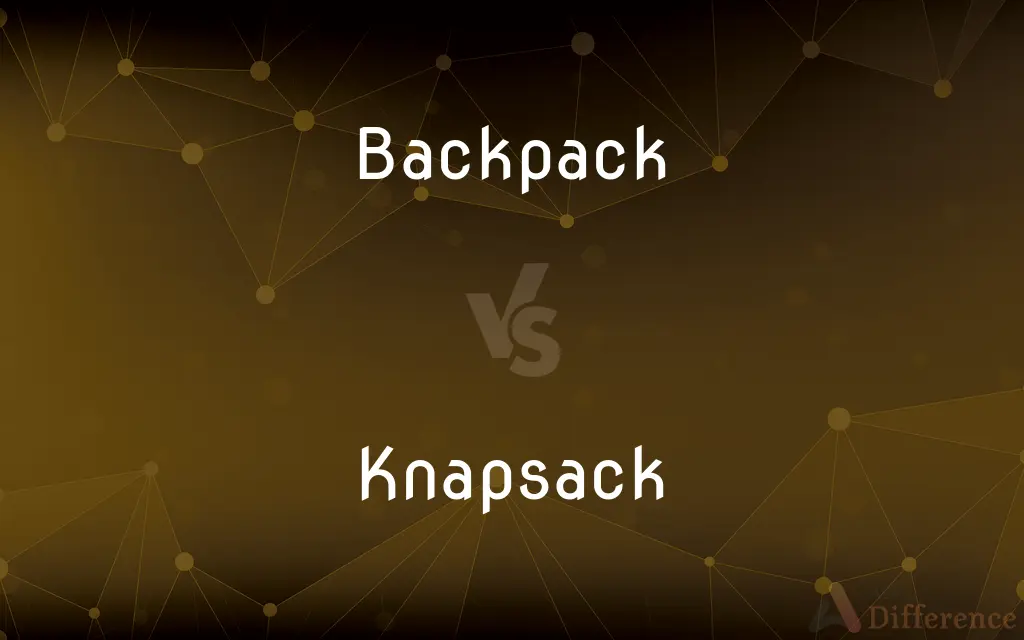Backpack vs. Knapsack — What's the Difference?
By Tayyaba Rehman & Urooj Arif — Updated on March 25, 2024
A backpack is a bag with shoulder straps that allow it to be carried on one's back, commonly used for travel or school, while a knapsack is often considered a type of backpack but may imply a simpler or smaller design, historically used by soldiers.

Difference Between Backpack and Knapsack
Table of Contents
ADVERTISEMENT
Key Differences
Backpacks and knapsacks serve similar purposes but have nuanced differences in usage and connotation. Conversely, the term "knapsack" might evoke a simpler or more traditional image. Historically, knapsacks were associated with military use or outdoor activities like hiking.
The evolution of backpack design reflects changes in technology, lifestyle, and user needs. Modern backpacks might include ergonomic features, waterproof materials, and built-in technology ports, catering to the needs of urban commuters, travelers, and students. In contrast, traditional knapsacks were more rudimentary, made from canvas or other durable fabrics, with a single compartment and perhaps a few pockets.
Cultural and regional preferences also play a role in the terminology. In some countries, "backpack" is the preferred term for all types of back-carried bags, while "knapsack" is more commonly used in others, sometimes carrying a nostalgic or specialized implication. For instance, in military contexts or historical discussions, "knapsack" may be used to describe the type of bag carried by soldiers in the past.
Despite these differences, the terms are often used interchangeably in casual conversation. The choice between "backpack" and "knapsack" may depend on personal preference, regional dialect, or the specific features of the bag in question. Both are designed to be carried on the back, freeing the hands and distributing the weight across the shoulders and back, making them practical choices for carrying personal items on the go.
Comparison Chart
Definition
A bag with shoulder straps to be carried on the back, designed for convenience and functionality.
Often a simpler, smaller backpack, historically used for essentials.
ADVERTISEMENT
Usage
Widespread for school, travel, and daily commute.
Historically associated with military or hiking, used for basic necessities.
Design Features
Multiple compartments, padding, specialized pockets, ergonomic features.
Typically simpler with fewer compartments; may lack modern ergonomic designs.
Material
Varies, including nylon, polyester, and waterproof materials.
Traditionally made from durable fabrics like canvas.
Cultural Connotation
Common and modern, with a focus on functionality and style.
May carry nostalgic or specialized implications, depending on the context.
Regional Preference
"Backpack" is predominantly used in the United States and many other countries.
"Knapsack" usage varies, more common in certain regions or for specific types of bags.
Compare with Definitions
Backpack
A versatile bag carried on the back, suitable for various activities.
She packed her laptop and textbooks into her backpack for school.
Knapsack
Implies a design with fewer compartments.
My grandfather’s knapsack had one main compartment and a small outer pocket.
Backpack
Reflects contemporary needs and lifestyles.
Urban commuters prefer backpacks with sleek designs and waterproof materials.
Knapsack
A simple, often smaller bag carried on the back.
He carried a knapsack with his lunch and a water bottle for the hike.
Backpack
Features multiple compartments for organization.
His backpack has a dedicated compartment for his camera equipment.
Knapsack
Made from traditional, durable materials.
Her vintage knapsack is made of heavy canvas and leather straps.
Backpack
Designed for ergonomic comfort.
The new backpack models boast improved shoulder straps and back padding.
Knapsack
Can carry a nostalgic or specialized connotation.
Collectors seek out authentic military knapsacks for their historical value.
Backpack
Often includes modern materials and technology-friendly features.
This backpack comes with a built-in USB charging port.
Knapsack
Historically used by soldiers or for outdoor activities.
The museum displayed a soldier’s knapsack from World War II.
Backpack
A backpack—also called knapsack, rucksack, rucksac, pack, sackpack, booksack, bookbag or backsack—is, in its simplest frameless form, a fabric sack carried on one's back and secured with two straps that go over the shoulders, but it can have an external frame, internal frame, and there are bodypacks. Backpacks are commonly used by hikers and students, and are often preferred to handbags for carrying heavy loads or carrying any sort of equipment, because of the limited capacity to carry heavy weights for long periods of time in the hands.
Knapsack
A bag made of sturdy material and furnished with shoulder straps, designed for carrying articles on the back.
Backpack
A sturdy bag designed for carrying articles on a person's back, having shoulder straps and often mounted on a lightweight frame.
Knapsack
A case of canvas or leather, for carrying items on the back.
Backpack
A piece of equipment, often containing life-support devices, designed to be used while being carried on the back
A parachute in a backpack.
An astronaut's backpack.
Knapsack
(cryptography) A set of values from which a subset is chosen.
Backpack
To hike or travel while carrying a backpack.
Knapsack
To go hiking while burdened with a knapsack, usually overnight or for longer.
My sleeping bag fell off my backpack into the water, while we were knapsacking up the mountain.
Backpack
To carry in a backpack.
Knapsack
A case of canvas, leather, nylon, or other sturdy fabric, fitted with straps, for carrying on the back the food, clothing, or other supplies for a soldier or a traveler; as, to hike up the mountain with lunch in a knapsack.
And each one fills his knapsack or his scripWith some rare thing that on the field is found.
Backpack
A knapsack, sometimes mounted on a light frame, but always supported by straps, worn on a person’s back for the purpose of carrying things, especially when hiking, or on a student's back when carrying books.
Knapsack
A bag carried by a strap on your back or shoulder
Backpack
A similarly placed item containing a parachute or other life-support equipment.
Backpack
(intransitive) To hike and camp overnight in backcountry with one's gear carried in a backpack.
Backpack
(intransitive) To engage in low-cost, generally urban, travel with minimal luggage and frugal accommodation.
Backpack
To place or carry (an item or items) in a backpack.
Backpack
A bag carried on the back, supported by straps looped over the shoulders.
Backpack
To hike while carrying a backpack; - often used in the form go backpacking; as, to backpack through the forest.
Backpack
A bag carried by a strap on your back or shoulder
Backpack
Hike with a backpack;
Every summer they are backpacking in the Rockies
Common Curiosities
Can I use a knapsack for school?
Yes, you can use a knapsack for school if it meets your needs, though backpacks might offer more organization and comfort features.
What is the main difference between a backpack and a knapsack?
The main difference lies in their design and connotation: backpacks are modern, with multiple features for convenience, while knapsacks are simpler and may have historical or military associations.
Is there a difference in the material used for backpacks and knapsacks?
Traditional knapsacks were often made from durable fabrics like canvas, while modern backpacks use a variety of materials, including nylon, polyester, and waterproof options.
Can both backpacks and knapsacks be used for hiking?
Yes, both can be used for hiking; the choice depends on the individual's needs, such as the capacity and specific features like hydration system compatibility.
How do I choose between a backpack and a knapsack?
Consider your needs, including the amount of gear you need to carry, organizational preferences, and any specific features like laptop compartments or waterproofing.
Are there any specific activities for which a knapsack is better suited than a backpack?
For simple day trips or activities requiring minimal gear, a knapsack might be preferable due to its lightweight and straightforward design.
How has the design of backpacks evolved compared to knapsacks?
Backpack designs have evolved significantly, incorporating ergonomic features, advanced materials, and technology-friendly pockets, whereas knapsacks remain simple.
Are knapsacks outdated?
Not necessarily; while traditional knapsacks have a more simplistic design, they are still used today, especially for lightweight travel or outdoor activities.
Why do people prefer backpacks over knapsacks?
People may prefer backpacks for their ergonomic design, additional features, and versatility for various activities.
What cultural significance do knapsacks have?
Knapsacks carry cultural significance in military history and outdoor exploration, symbolizing simplicity and ruggedness.
Share Your Discovery

Previous Comparison
Renowned vs. Renown
Next Comparison
Through vs. ThroughoutAuthor Spotlight
Written by
Tayyaba RehmanTayyaba Rehman is a distinguished writer, currently serving as a primary contributor to askdifference.com. As a researcher in semantics and etymology, Tayyaba's passion for the complexity of languages and their distinctions has found a perfect home on the platform. Tayyaba delves into the intricacies of language, distinguishing between commonly confused words and phrases, thereby providing clarity for readers worldwide.
Co-written by
Urooj ArifUrooj is a skilled content writer at Ask Difference, known for her exceptional ability to simplify complex topics into engaging and informative content. With a passion for research and a flair for clear, concise writing, she consistently delivers articles that resonate with our diverse audience.














































